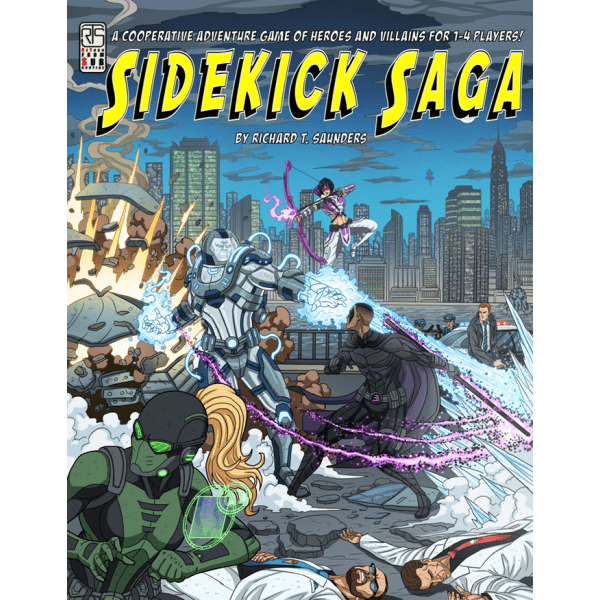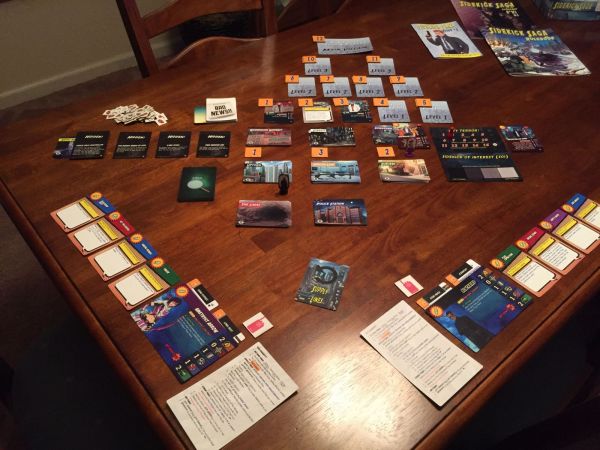Sidekick Saga: A Cooperative Comic Book Caper on Kickstarter

The heroes have all gone missing, and it is up to their sidekicks to protect the city and get to the bottom of this mystery!
In Sidekick Saga, each player takes on the role of a sidekick and all work together to complete the mission’s objective. The game is currently on Kickstarter, so how does this newest superhero game play?
Gameplay
You start by selecting what level you will be playing, either a one-shot scenario or one of the six chapters in the campaign (or issues as the game calls them). The level you are playing tells you which cards to use, which locations are involved, win and lose conditions if unique, and how to arrange the villain cards.
Each player chooses a character, each of which has two unique powers. The city is represented by several decks of cards, each deck belonging to a different location. These are laid out in a grid on the table and your place your character directly beneath his or her starting location deck. The villains are placed face down in more or less a pyramid. The villains directly below another villain card are considered to be ‘protecting’ that villain, and you cannot attack a protected villain until you have defeated (or put into disarray) the villains that are protecting it.
At the start of each turn, a bad news card is drawn. This causes trouble throughout the city — for example, it may cause gangs to appear in the city. (Gangs will cause the city terror level to rise at the end of the turn if left undefeated or not in disarray, and players lose the game if city terror hits sixteen.) The bad news deck is divided into three phases: day, afternoon, and night. After each phase, you put the hero’s discarded cards back into their respective decks. If the bad news deck runs out and heroes have not won the game, they lose.
Next, you reveal the next villain card in the pyramid, and mark which location that villain appears in. Then the turn moves on to the sidekick phase, when players take actions. Players may move around the city (each character has a certain number of movement points, and you may spend one movement point to move onto any adjacent, non-diagonal city deck), you then draw one location card from your current location deck and place it in your hand, and you decide if your hero will be in their hero form or in their secret identity form. Next, you pass as many cards as you wish to the player directly to your left or right (the direction changes after each phase of the bad news deck).
Finally players take their execute actions. This means if you are in your secret identity that you draw a lead card and may play cards (but you cannot engage in combat). If you are in your hero form, you may choose to either play cards, move your character to the top of the SOI chart (the SOI chart determines who will be attacked in certain instances), or place a gang into disarray.
The combat phase then occurs. There are two types of combat: physical and hacking. Player characters and villains have attack power, defense, range for their attacks, hacking power, and hacking defense listed on their cards. Players can use cards to affect these numbers. During the combat phase, player hack attacks are resolved first. If the player’s hacking power number exceeds the target’s hacking defense number, the target is put into disarray. Depending on the strength of the attack, the disarray can last up to three turns. Next, bad guy attacks are resolved. Range determines which, if any, nearby locations an attack can hit. Players take damage for each point of attack that exceeds their defense. If it was a hack attack, you lose a card. Finally, players resolve their physical attacks against villains. If a player ever reaches zero hit points, she moves to her starting location, and must remain in her secret identify form for the rest of the game. If all heroes are knocked out, they lose the game.
This leads to the end of the turn and a new turn begins. Players are generally attempting to defeat the main villain in order to win.
During each game there are also a certain number of hidden equipment cards. Players may discard lead cards in order to unlock these. If you are playing through the campaign, unlocked equipment cards carry over from one level to the next. Also, when you start the game you have a certain number of cards available to you, but as you play through the campaign, more cards are added and you unlock more heroes.
Review
Sidekick Saga is thematic, challenging, and introduces some fun cooperative concepts. The game stresses the sense of being spread out across the city, with limited communication, and only being able to pass cards to certain players. This forces you to plan several steps ahead. Since you can also make yourself a target to enemy attacks, and as defeating bad guys also makes you more of a target on the SOI chart, there’s also some fun opportunities to manipulate this to your advantage and have some control over enemy turns.
The game has elements of legacy games, having cards you only look at once you reach certain points in the campaign, introducing new cards as you go. In fact, you can only play certain scenarios once you’ve unlocked certain cards. But there’s no destruction of components, and you could relatively easily reset the game back to square one (though you can leave the cards out and still play through the earlier missions once more with the newly unlocked heroes).
In general, there is a lot of replayability in this game. Not only can you replay the campaign, but there’s also the book of standalone scenarios. Also, once you grow more familiar with the game you can create your own personal sidekick hero, which adds a touch of personalization, and a character you can really feel invested in.
The story itself that plays out over the games is interesting and fun. It, along with the artwork of the game, gives a real feel to the world you are playing in, helped along by the fact that the game really commits to the comic book theme, with one of the neatest elements being that they present the setup to each chapter in the campaign in a small, comic book issue sized booklet.
Sidekick Saga isn’t truly a casual board game. The set up and rule teaching takes some time and the game runs over an hour. It’s more of a midpoint game between casual cooperatives such as Forbidden Island and something heavy like Arkham Horror. As such it could be a great meeting point for friends with varying board game tastes.
If you’re interested in a heftier game and love your superheroes, Sidekick Sage is well worth checking out on Kickstarter. It’s challenging, thematic, and offers a fun experience that can be played out over several evenings.
Pros: Good story, theme runs through the game and components, enjoyable cooperative elements, sense of the world you are playing in
Cons: Long set up time and game time, rules will take a while to learn
Disclosure: this preview is based on our evaluation of an unpublished prototype of the game, which is subject to change prior to publication. While a modest payment was received to expedite the review process, our thoughts and opinions expressed here are honest and accurate.





